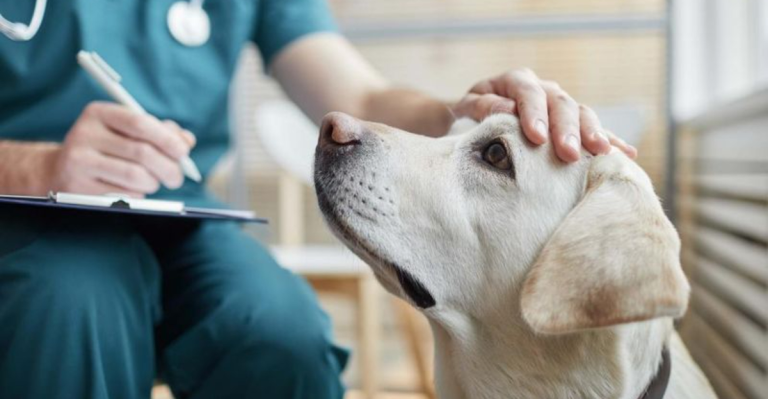16 Heartfelt Ways Dogs Say Goodbye Before They Cross The Rainbow Bridge
There’s a special kind of love that only exists between a human and their dog—loyal, wordless, and soul-deep. So when it’s time to say goodbye, the heartbreak cuts like nothing else. Losing a canine companion isn’t just the end of a chapter; it’s the quiet disappearance of a presence that once filled every corner of your home and heart.
But what if your dog tried to tell you it was time?
Many devoted pet parents have shared eerily similar stories of dogs behaving in strange, tender, or even spiritual ways in their final days. They speak of sudden changes in routine, long, lingering stares, and affectionate gestures that feel almost like final gifts. It’s as if our furry companions—despite aging bodies or failing health—summon the strength to send one last message: I know I’m going, but I want you to be okay.
These signs aren’t random. They’re part instinct, part emotion, and perhaps something more mysterious. From a sudden need for solitude to a last-minute burst of playfulness, dogs often exhibit behaviors that seem to bridge the worlds of life and death. Understanding these final acts can bring comfort when grief feels overwhelming, turning heartache into gratitude for a love that was true until the very end.
This article explores the subtle and sometimes astonishing ways dogs say farewell. Whether it’s through a shared gaze, a final walk, or a beloved toy placed gently in your lap, these moments can offer closure—and an enduring reminder of a bond that doesn’t die with the body.
So if you’ve ever wondered whether your dog was trying to say goodbye, the answer is almost certainly yes. And what they left you with was more than memories—it was meaning.
1. Seeking Solitude
Dogs often withdraw from family activities when they sense their time is near. Your normally social pup might start hiding under furniture, retreating to quiet corners of the yard, or spending more time in rarely used rooms. This behavior mimics what wild canines do in nature.
The instinct to separate from the pack runs deep, as animals naturally seek peaceful isolation when vulnerable. Your dog isn’t rejecting you but following an ancient calling to find tranquility during their transition.
While this behavior can feel hurtful, understanding it as a natural process rather than abandonment helps provide perspective during this emotional time.
2. Unusual Affection
A normally independent dog might suddenly become your shadow, refusing to let you out of sight. This increased clinginess often manifests as extended cuddle sessions, persistent following, or unusual neediness from typically self-sufficient pets.
Your furry friend may gaze deeply into your eyes more frequently, something dogs generally reserve for beings they deeply trust. Some pet parents report their dogs initiated more physical contact through gentle paw touches or resting their head on laps.
This behavior represents your companion’s desire to strengthen your bond one last time and absorb the comfort of your presence while they still can.
3. Giving Meaningful Objects
Has your dog started bringing you their most treasured possessions? This touching behavior often surprises owners who find their pets delivering favorite toys, bones, or comfort items directly to them in their final days.
Rover might place his beloved squeaky toy in your lap or drag his cherished blanket to your feet. These aren’t random acts but deliberate gestures of transfer – your dog is entrusting their most valued possessions to your care.
This heartfelt behavior represents your companion’s way of leaving you with physical reminders of their love and ensuring their treasures remain with someone they trust completely.
4. Renewed Energy Spurts
Many pet parents describe a puzzling phenomenon in their dog’s final days – a sudden burst of vitality veterinarians call the “rally.” Your previously lethargic companion might suddenly want to play fetch or request a walk like old times.
These temporary energy surges can feel like miraculous improvements, but they often represent a final gift – one last chance to create joyful memories together. Your dog may revisit favorite spots or activities they’ve long abandoned due to age or illness.
Treasure these moments without false hope. This mysterious final energy reserve allows many dogs to participate in meaningful goodbye activities with their beloved humans.
5. Refusing Food But Accepting Comfort
A dog’s declining interest in food often signals their body’s natural preparation for transition. Even treats that once excited them may be gently refused as their digestive system begins shutting down. This isn’t stubbornness but a biological process.
While rejecting meals, many dogs show increased receptiveness to comfort measures like gentle massage, soft blankets, or quiet companionship. Your furry friend may turn their head from the food bowl but lean into your touch more than ever.
This shift represents their changing needs – physical nourishment becomes less important than emotional sustenance during their final journey.
6. Making Peace With Old Rivals
Dogs approaching their final days often resolve long-standing conflicts with other household pets. The cat your dog chased for years might suddenly be allowed to sleep nearby without incident. That neighborhood dog who always triggered barking frenzies might receive calm acknowledgment instead.
This peacekeeping behavior stems from your dog’s decreasing territorial instincts as their focus shifts from protecting resources to conserving energy. Many owners witness surprising moments of tolerance or even affection between formerly feuding animals.
Your wise companion understands that energy spent on old rivalries no longer serves them, choosing instead to create harmony in their environment during their remaining time.
7. The Final Check-In Tour
Many dogs undertake a methodical household inspection before their departure. Your aging companion might slowly visit each room, sniffing corners and lingering in meaningful spots as if taking inventory of their territory one last time.
This behavior extends beyond your home – during final walks, they often pause at significant landmarks or neighbors’ homes that held importance in their lives. Some dogs will gently acknowledge each family member with brief moments of connection during this survey.
This farewell tour represents your dog’s way of creating closure with their physical world, mentally cataloging the environment they’ve protected and enjoyed throughout their lifetime.
8. Attempting Impossible Journeys
Some dogs display a powerful urge to travel just before passing. Your weakened companion might suddenly attempt to go outside despite physical limitations or try reaching locations significant to them – perhaps a favorite hiking trail or beach spot miles away.
This behavior connects to ancestral instincts where wild canines would separate from their pack for their final moments. Your dog might seem confused or restless, trying to reach a destination they can’t quite communicate.
While concerning, this journey-seeking represents an important transition phase. Creating a safe, comfortable space that honors this instinct while keeping them protected shows respect for their natural process.
9. Unusual Vocal Communications
Typically quiet dogs may become surprisingly vocal in their final days. These sounds range from soft whimpers to howls unlike any noise they’ve made before. Your normally barky companion might instead fall unusually silent, communicating more through eye contact than sound.
Some owners report their dogs making distinct vocalizations that seem directed specifically at them – almost conversational in nature. These unique communications often occur during quiet moments together and feel deeply personal.
These vocal changes represent your dog’s attempt to share important final messages when traditional communication methods no longer suffice. Listen closely – they’re telling you something meaningful.
10. The Knowing Gaze
Perhaps the most haunting goodbye sign is the profound eye contact many dogs initiate near their end. This isn’t ordinary eye contact but a deep, soulful gaze that many owners describe as feeling almost supernatural in its intensity and meaning.
Your dog might seek out these eye-connecting moments repeatedly, holding your gaze longer than usual. Their expression often appears eerily calm, wise, and reassuring despite their physical condition.
Many grieving pet parents later report this specific gaze brought them unusual comfort, feeling their dog was communicating understanding, gratitude, and reassurance that crossing the Rainbow Bridge was the right next journey.
11. Seeking Specific Family Members
Dogs often display clear preferences for certain family members during their final days. Your pet might suddenly seek out the family member they’ve been most bonded with, refusing to leave their side. Alternatively, some dogs gravitate toward the person they sense needs the most closure or healing.
Sometimes this behavior surprises families when the dog chooses someone unexpected – perhaps the quietest family member or the one who’s been away. This selection isn’t random but reflects your dog’s deep understanding of emotional connections.
Trust your companion’s wisdom in these choices – they’re creating meaningful final moments with those they believe need them most.
12. Rearranging Sleeping Spots
Many dogs change their sleeping locations as they prepare for transition. Your pet might abandon their comfortable bed to sleep on hard floors or move from sleeping with you to choosing isolated spots. Some dogs select unusual places like under specific furniture or near doorways.
This behavior connects to wild canines’ instinct to find secure, sheltered places for vulnerable moments. Your dog isn’t rejecting comfort but following deep instincts about where they feel safe to let go.
Creating comfortable spaces in these newly chosen areas shows respect for their process while still providing the physical support they need during this vulnerable time.
13. Watching Something Invisible
Many owners report their dogs staring fixedly at empty corners or tracking movement no one else can see in their final days. Your pet might tilt their head curiously or wag their tail at apparently empty spaces, seeming to acknowledge presences only they can detect.
While science suggests this could relate to neurological changes affecting vision, many find comfort believing their companions might be perceiving spiritual guides or previously departed pets welcoming them. Some dogs appear notably peaceful during these moments rather than distressed.
Whatever explanation resonates with you, these moments often bring a strange comfort to witnessing humans – a reminder that transition contains mysteries beyond our understanding.
14. Accepting Help With Dignity
Fiercely independent dogs often show a profound shift by gracefully accepting assistance with basic needs. Your formerly private pet might suddenly allow you to help with grooming, bathroom needs, or mobility without their usual resistance.
This surrender isn’t defeat but a conscious choice to accept care from trusted hands. Many owners describe feeling their dogs gave permission for help through subtle signals – a gentle lean into support or relaxed acceptance of assistance they would have previously rejected.
This behavior represents beautiful trust – your companion communicating they understand your help comes from love and acknowledging their changing needs during this vulnerable transition time.
15. Momentary Return To Puppyhood
Some dogs display touching flashbacks to puppy behaviors in their final days. Your dignified senior might suddenly pounce playfully at toys they haven’t touched in years or perform silly antics reminiscent of their youth.
These playful moments often emerge unexpectedly between periods of rest, almost like brief visits to happier, more energetic times. Families report these episodes feeling like precious gifts – chances to glimpse their beloved companion as they once were.
Cherish these moments as special opportunities to connect with your dog’s essential spirit beyond age and illness. They represent your pet’s way of reminding you both of the joyful life you’ve shared together.
16. The Peaceful Final Surrender
Perhaps the most profound goodbye comes when dogs show they’re ready for their journey. This manifests as a distinctive calm that replaces previous restlessness or pain. Your struggling companion might suddenly appear serene, their breathing pattern changing to something slower and more deliberate.
Many owners describe feeling their dog waited for a specific moment – perhaps until they stepped away briefly or conversely, until they returned home. Some dogs seem to choose meaningful dates like birthdays or anniversaries.
This final act of love demonstrates your dog’s concern for your feelings even in their last moments, often choosing their departure time with surprising intentionality and awareness.






















